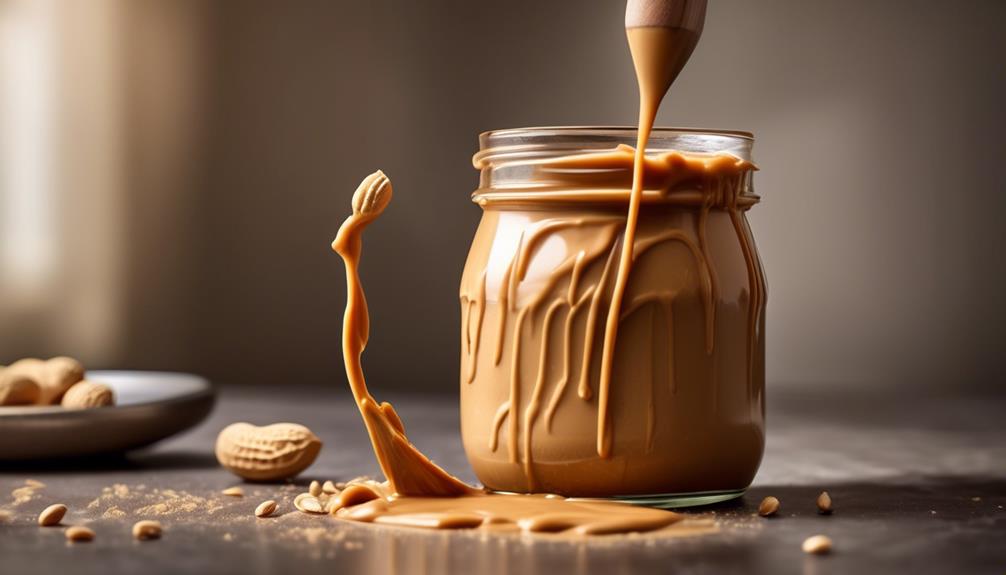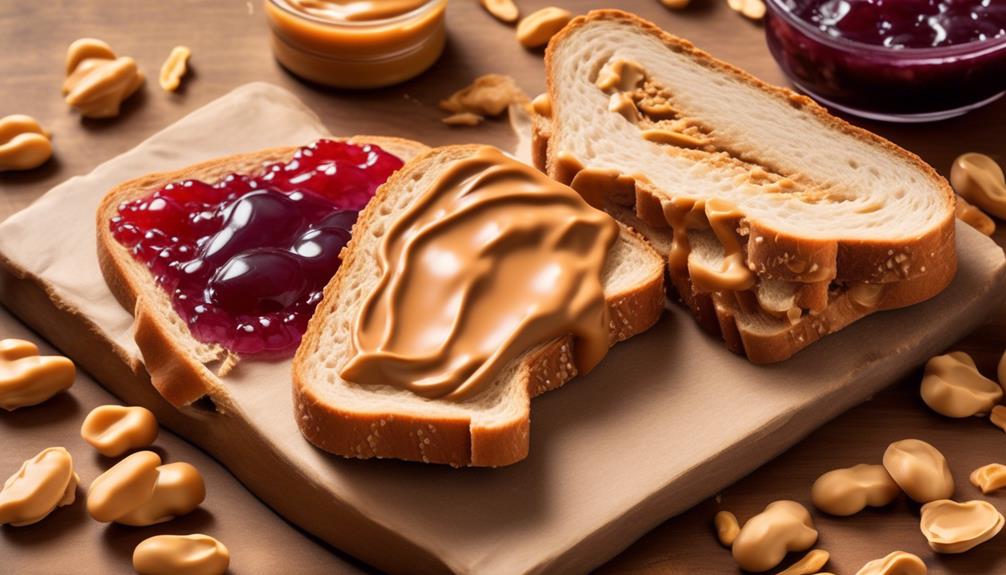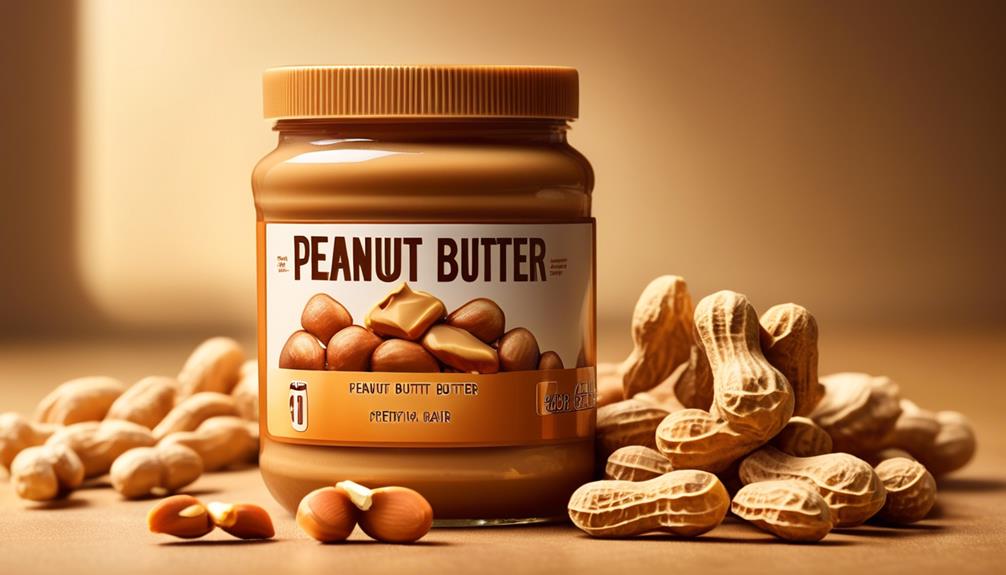We have all been through the annoyance of grabbing a jar of peanut butter and seeing a layer of oil on top. But don’t worry, there are reliable ways to prevent peanut butter from separating without having to constantly stir or refrigerate it.
By understanding the science behind the separation and utilizing a few simple techniques, you can enjoy the creamy, smooth texture of peanut butter without the hassle of dealing with excess oil.
So, what are these techniques? Stay tuned to discover the secrets to maintaining the perfect consistency of your favorite spread.
Key Takeaways
- Refrigerating the jar of peanut butter and storing it upside down can help prevent separation and extend shelf life.
- Mixing techniques such as using an immersion blender or adding a small amount of neutral oil can help achieve a smooth consistency.
- Stabilizers like palm oil or hydrogenated fats can be added to peanut butter to prevent separation and maintain spreadability.
- When choosing peanut butter, prioritize natural options without added stabilizers and look for brands that use only peanuts and salt.
Storing Peanut Butter Properly
Refrigerate the jar of peanut butter to help prevent separation and extend its shelf life, a practice that's recommended by experts for optimal storage. Storing peanut butter properly is crucial for maintaining its spreadable consistency and natural flavor.
When kept in the fridge, the cooler temperature slows down the natural oil separation process, keeping the peanut solids and oil well combined. Another tip is to store the jar upside down, allowing the oil to rise to the bottom. Then, flip it back over to redistribute the oil evenly. This simple trick can help maintain the homogeneity of the peanut butter, making it easier to mix before each use.
Mixing Techniques for Smooth Consistency

To achieve a smooth consistency in natural peanut butter, consider utilizing the upside-down storage trick to redistribute the oil and solid contents effectively. This simple technique can help maintain a homogeneous texture in your peanut butter.
Additionally, re-emulsifying separated natural peanut butter using an immersion blender or alternative methods such as using a food processor, adding a small amount of neutral oil, or stirring vigorously can also help achieve a smooth consistency.
Storing natural peanut butter in the fridge may prevent separation, but it could make the peanut butter harder to spread. However, storing the jar upside down in the fridge can help distribute the oil evenly.
Another option to consider is adding liquid soy lecithin to the nuts to bond the peanuts to any natural oils released during processing, thus helping to achieve the desired consistency.
These techniques provide practical solutions for maintaining the smooth texture of natural peanut butter, ensuring a delightful and satisfying spread every time.
Using Additives to Prevent Separation

Utilizing stabilizers like palm oil or hydrogenated fats is a common method to prevent the separation of oil and solids in peanut butter, maintaining a consistent texture and prolonging its shelf life. These additives are commonly found in highly processed peanut butters and serve to increase viscosity and prevent oil from separating from the solids.
By incorporating stabilizers, natural peanut butter can also benefit from a longer shelf life and reduced oil separation, making it a practical choice for those who enjoy the natural taste but want to avoid frequent stirring. Additionally, stabilizers help maintain the spreadability and texture of peanut butter over time, ensuring a smooth and creamy consistency with every use.
While some individuals prefer to make their own peanut butter to avoid stabilizers and hydrogenated fats, it's important to note that many commercial peanut butters contain these additives.
Refrigerating Versus Room Temperature Storage

Storing natural peanut butter in the refrigerator can effectively slow down the separation of oil from the solids by reducing the oil's ability to rise to the top. When it comes to deciding between refrigerating or storing at room temperature, there are several factors to consider:
- Consistency: Refrigeration helps maintain the peanut butter's consistency and prevents separation, but it can make it harder to spread.
- Prevention of Separation: Refrigerating can keep the oil from forming a layer on top, while room temperature storage may lead to quicker separation due to warmer conditions.
- Practicality: Room temperature storage may result in easier spreading, but it could also lead to quicker separation.
- Even Distribution: Regardless of storage method, using the upside-down storage trick can help redistribute the oil evenly by allowing gravity to do the work.
In my experience, refrigerating natural peanut butter has been beneficial in maintaining its quality and reducing the need to constantly mix the oil back in. However, it's important to consider personal preferences for spreadability and the frequency of use when deciding between refrigerating and room temperature storage.
Choosing the Right Peanut Butter Brand

When selecting a peanut butter brand, it's important to prioritize natural options without added stabilizers to maintain a healthier choice and prevent separation. Look for peanut butter that contains only peanuts and salt for a healthier option, without added palm oil or fully hydrogenated or hydrogenated fats.
According to the National Peanut Board, it's essential to check the label for a minimum of 90% peanuts to ensure it's labeled as peanut butter, not peanut spread. Opt for brands that use only peanuts to avoid the need for stabilizers and other additives.
Real Simple suggests refrigerating natural peanut butter to prevent separation, but it's important to note that some natural peanut butters may not require refrigeration.
When making the peanut butter selection, consider the overall texture and consistency that you prefer, as some natural peanut butters may have a slightly different texture compared to conventional options.
Frequently Asked Questions
How Do They Make Peanut Butter Not Separate?
To prevent peanut butter separation, we store it upside down, allowing the oil to rise to the bottom. After flipping it back, a quick shake redistributes the oil, preventing separation.
This method works for almond and cashew butter too, and refrigeration fully prevents separation.
Opt for natural peanut butter with only peanuts and salt for a healthier option.
Store mixed natural peanut butter in the fridge and use alternative methods to remix separated peanut butter.
How Do You Stabilize Peanut Butter?
We stabilize peanut butter by following these practical steps:
- Store the jar upside down to allow oil separation.
- Flip it over and give it a quick shake to redistribute the oil.
- If needed, blend the separated contents using an immersion blender or warm the peanut butter slightly before stirring.
Refrigerating natural peanut butter prevents separation, but it may harden.
Regularly checking for oil separation ensures its purity and shelf life.
How Do You Emulsify Separated Peanut Butter?
To emulsify separated peanut butter, we can try a few methods.
First, stir the separated content to mix it back together.
If that doesn't work, try adding a small amount of neutral oil and blend it well.
Alternatively, storing the peanut butter in the fridge can help prevent separation.
Another method is to use an immersion blender to blend the separated contents back together.
These methods can help restore the creamy consistency of the peanut butter.
Should You Refrigerate Peanut Butter After Opening?
Refrigerating peanut butter after opening extends its shelf life and helps prevent oil separation, ensuring a smoother texture. It's crucial for natural peanut butter, as the absence of stabilizers makes it prone to separation.
Our team recommends this simple step to maintain the quality of your peanut butter. Refrigeration also prevents spoilage and rancidity, keeping your favorite spread fresh for longer.
Conclusion
In the end, keeping peanut butter from separating is like finding the perfect balance in a dance.
By storing it properly, using the right mixing techniques, and incorporating additives like liquid soy lecithin, we can achieve a smooth and consistent texture.
Whether it's for a quick snack or a special treat, knowing how to prevent separation allows us to savor every creamy bite without worry.









